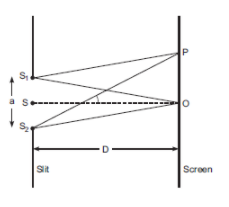
Use Huygens principle to explain the formation of diffraction patterns due to a single shit illuminated by a monochromatic source at light. When the width of the shit is made double the original width, how would this affect the size and intensity of the central diffraction band?
Answer
572.4k+ views
Hint: Use the concept of Huygens’s principle.
Use the young slit experiment for this problem.
Complete step by step solution:
According to the Huygen's principle "The net effect at any point due to the number of wavelets is equals to sum total contribution at all wavelets with proper phase difference

The point N is Maxima because from each part of the slit S1 RS2 is in phase means the path difference is O.
At point M
(i) If \[{{S}_{2}}i-{{S}_{1}}i=n\lambda \] then point p would be minimum
(ii) If \[{{S}_{2}}P-{{S}_{1}}P=\left( 2n+1 \right)\dfrac{\lambda }{2}\] then point P would be Maxima. At the point of Maxima, intensity will decrease.
The width of the central Maxima is given by \[\dfrac{S\lambda D}{a}\]
Where
\[\lambda =\]Wavelength
\[D=\] Distance between screen and the slit
\[a=\] Size of the slit
When the width of the slit is made double the original width then the size of the central maxima will be reduced to half and intensity will be four times.
Note: Student should be better understanding of Huygens’s principle. The young slit experiment observes carefully. The width of the slit makes a huge impact on calculations.
Use the young slit experiment for this problem.
Complete step by step solution:
According to the Huygen's principle "The net effect at any point due to the number of wavelets is equals to sum total contribution at all wavelets with proper phase difference

The point N is Maxima because from each part of the slit S1 RS2 is in phase means the path difference is O.
At point M
(i) If \[{{S}_{2}}i-{{S}_{1}}i=n\lambda \] then point p would be minimum
(ii) If \[{{S}_{2}}P-{{S}_{1}}P=\left( 2n+1 \right)\dfrac{\lambda }{2}\] then point P would be Maxima. At the point of Maxima, intensity will decrease.
The width of the central Maxima is given by \[\dfrac{S\lambda D}{a}\]
Where
\[\lambda =\]Wavelength
\[D=\] Distance between screen and the slit
\[a=\] Size of the slit
When the width of the slit is made double the original width then the size of the central maxima will be reduced to half and intensity will be four times.
Note: Student should be better understanding of Huygens’s principle. The young slit experiment observes carefully. The width of the slit makes a huge impact on calculations.
Recently Updated Pages
Master Class 12 Business Studies: Engaging Questions & Answers for Success

Master Class 12 Economics: Engaging Questions & Answers for Success

Master Class 12 English: Engaging Questions & Answers for Success

Master Class 12 Maths: Engaging Questions & Answers for Success

Master Class 12 Social Science: Engaging Questions & Answers for Success

Master Class 12 Chemistry: Engaging Questions & Answers for Success

Trending doubts
What is meant by exothermic and endothermic reactions class 11 chemistry CBSE

Which animal has three hearts class 11 biology CBSE

10 examples of friction in our daily life

One Metric ton is equal to kg A 10000 B 1000 C 100 class 11 physics CBSE

1 Quintal is equal to a 110 kg b 10 kg c 100kg d 1000 class 11 physics CBSE

Difference Between Prokaryotic Cells and Eukaryotic Cells




